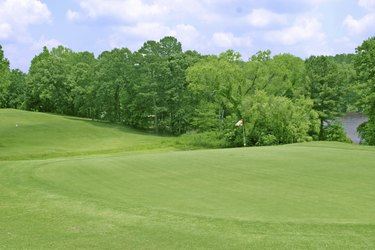
Dense, carpetlike growth and outstanding drought tolerance make zoysia grass (Zoysia spp.) a welcome alternative to water-greedy lawn grasses in much of the United States. Hardy in U.S. Department of Agriculture plant hardiness zones 5 through 10, zoysia stands up to heat, humidity and traffic when other grasses are struggling. Zoysia isn't without challenges, but proper management and timely maintenance keep common zoysia problems at bay.
Warm-Season Demands
Video of the Day
Unlike cool-season grasses that flourish in fall and spring, zoysia thrives in warmth. Its active growing season and emerald color arrive in late spring and end by late summer. Requisite zoysia-lawn tasks such as dethatching, aerating and fertilizing must be done during summer before zoysia goes dormant and turns brown in fall. For gardeners, this means handling arduous tasks during the year's hottest months. The timing causes problems for some, but ignoring it causes bigger problems for zoysia lawns. Fertilizing zoysia during cool seasons encourages weeds, poor root development and delayed dormancy. All put your lawn at risk for stress and loss.
Video of the Day
Heat-Related Issues
Although zoysia tolerates heat and drought, extremes cause winterlike dormancy during the growing season. Thirsty, overheated lawns turn dull brown when they should be rich green. Prominent, sloping areas near streets and walkways often bear the brunt of brownness. Without relief, zoysia may pass from dormancy to death. Telling the difference can be difficult. Lawns must be irrigated to keep dormant zoysia alive. Keeping the grass green requires even more water and a delicate balance. Soil, climate and zoysia health all affect watering needs. The grass won't tolerate standing water either. Overwatering leaves zoysia susceptible to infestations by pests and disease.
Cool-Season Competition
Zoysia holds its own in sunny, warm weather to the point of invading neighboring lawns and gardens. It spreads vigorously through underground rhizomes and above-ground stolons, but it doesn't compete well in shade or cool weather. Trees and shrubs limit zoysia's light and out-compete the grass for moisture and soil nutrients. Cool-season grasses and weeds seize the opportunity to move in when warm-season zoysia rests. Low light leads to weak, sparse turf, and limited moisture triggers droughtlike dormancy. Competition creates patchwork lawns of brown zoysia and green competitors in cool months, and green zoysia peppered with dormant cool-season grasses in summer.
Opportunistic Invaders
When heat, poor water management or ill-timed maintenance takes a toll on zoysia, diseases and insect pests pounce. Unattended thatch adds to problems. Large patch disease, caused by the fungus Rhizoctonia solani, capitalizes on overzealous irrigation and hot weather to infect zoysia lawns. By the time symptoms are evident, fungicides are ineffective. Hot, dry conditions bring out zoysia's nemesis, the chinch bug (Blissus spp.), and other insects that cause droughtlike damage and draw foraging rodents as well. The best defense against problems from year to year remains timely maintenance and proper management that keeps zoysia at the peak of health.